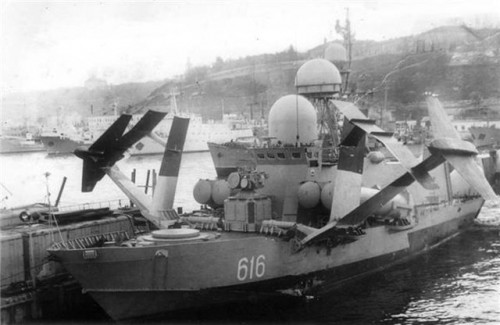Designed and built in Leningrad, the SARANCHA (NATO Code Name) is a hydrofoil with a surface-piercing foil system forward and a fully-submerged configuration aft. The bow foil is a split V surface-piercing type (seen in the illustration) which carries about 60% of the lift and the single fully submerged foil aft carries the remaining 40%. The rear foil is supported by two vertical struts, each of which carries a propeller on each end of the propulsion pod at the lower end of the strut. Note that this foilborne propulsion Z-drive is similar in configuration to that of the U.S. Navy PCH-1 HIGH POINT designed in 1960.
SARANCHA has two Soviet NK-12MV 12,000 to 15,000 hp marine gas turbines installed to provide a maximum speed of greater than 50 knots.
At 330 tons (about the same full load weight of PLAINVIEW), SARANCHA was the largest operational naval hydrofoil at the time. As with PLAINVIEW, it also had a foilborne powerplant of about 30,000 hp, and transmitted its power to the water through two super-cavitating propellers.
The 147 ft SARANCHA had a beam across the foils in the extended position of 75.5 ft. From the illustration one can see that the retraction arrangement is similar to that of FLAGSTAFF and PLAINVIEW. Foil control was obtained through an electronic auto-stabilization system. A point of contrast with U.S. hydrofoil designs, however, is the utilization of rudders on the trailing edges of the aft struts of SARANCHA to improve its maneuverability. The rudders are probably used because of the large surface-piercing foil system forward, which makes it more difficult to roll into a turn and accomplish a coordinated maneuver, particularly at high speed.
Soviet Navy operational testing of SARANCHA began in the eastern Baltic in mid-1977. Armament on the ship consisted of four SS-N-9 anti-ship missiles on lightweight launchers amidship, one twin SA-N-4 surface-to-air missile launcher with 15 to 20 missiles on the forward deck and one 30 mm Gatling-type rapid fire anti-aircraft cannon aft. Each of these was of course accompanied by its fire control radar along with navigation radar and an electronic countermeasures (ECM) suite.
The MRK-5 (МРК-5) was laid down at the Petrovski plant in Leningrad in 1973 and was on trials until 1977. In 1979 She was the transferred to the Black Sea Fleet via Russian inland waterways. She was based in Sevastopol until 1990 when she was decommissioned. In 1992 she was damaged by fire and sunk in shallow water. The wreck was raised and scrapped.
